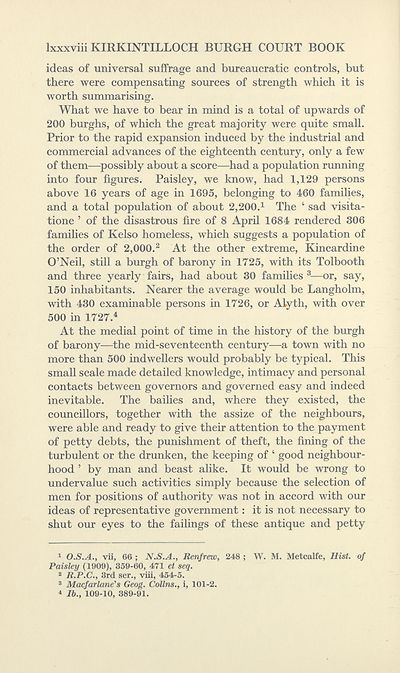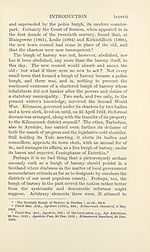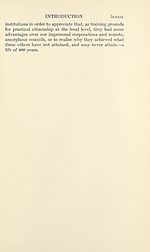Series 3 > Court book of the Burgh of Kirkintilloch 1658-1694
(95) Page lxxxviii
Download files
Complete book:
Individual page:
Thumbnail gallery: Grid view | List view

Ixxxviii KIRKINTILLOCH BURGH COURT BOOK
ideas of universal suffrage and bureaucratic controls, but
there were compensating sources of strength which it is
worth summarising.
What we have to bear in mind is a total of upwards of
200 burghs, of which the great majority were quite small.
Prior to the rapid expansion induced by the industrial and
commercial advances of the eighteenth century, only a few
of them—possibly about a score—had a population running
into four figures. Paisley, we know, had 1,129 persons
above 16 years of age in 1695, belonging to 460 families,
and a total population of about 2,200.1 The ‘ sad visita-
tione 5 of the disastrous fire of 8 April 1684 rendered 306
families of Kelso homeless, which suggests a population of
the order of 2,000.2 At the other extreme, Kincardine
O’Neil, still a burgh of barony in 1725, with its Tolbooth
and three yearly fairs, had about 30 families 3—or, say,
150 inhabitants. Nearer the average would be Langholm,
with 430 examinable persons in 1726, or ALyth, with over
500 in 1727.4
At the medial point of time in the history of the burgh
of barony—the mid-seventeenth century—a town with no
more than 500 indwellers would probably be typical. This
small scale made detailed knowledge, intimacy and personal
contacts between governors and governed easy and indeed
inevitable. The bailies and, where they existed, the
councillors, together with the assize of the neighbours,
were able and ready to give their attention to the payment
of petty debts, the punishment of theft, the fining of the
turbulent or the drunken, the keeping of ‘ good neighbour¬
hood ’ by man and beast alike. It would be wrong to
undervalue such activities simply because the selection of
men for positions of authority was not in accord with our
ideas of representative government: it is not necessary to
shut our eyes to the failings of these antique and petty
1 O.S.A., vii, 66 ; N.S.A., Renfrew, 248 ; W. M. Metcalfe, Hist, of
Paisley (1909), 359-60, 471 et seq.
2 R.P.C., 3rd ser., viii, 454-5.
3 Maefarlane's Geog. Colins., i, 101-2.
4 lb., 109-10, 389-91.
ideas of universal suffrage and bureaucratic controls, but
there were compensating sources of strength which it is
worth summarising.
What we have to bear in mind is a total of upwards of
200 burghs, of which the great majority were quite small.
Prior to the rapid expansion induced by the industrial and
commercial advances of the eighteenth century, only a few
of them—possibly about a score—had a population running
into four figures. Paisley, we know, had 1,129 persons
above 16 years of age in 1695, belonging to 460 families,
and a total population of about 2,200.1 The ‘ sad visita-
tione 5 of the disastrous fire of 8 April 1684 rendered 306
families of Kelso homeless, which suggests a population of
the order of 2,000.2 At the other extreme, Kincardine
O’Neil, still a burgh of barony in 1725, with its Tolbooth
and three yearly fairs, had about 30 families 3—or, say,
150 inhabitants. Nearer the average would be Langholm,
with 430 examinable persons in 1726, or ALyth, with over
500 in 1727.4
At the medial point of time in the history of the burgh
of barony—the mid-seventeenth century—a town with no
more than 500 indwellers would probably be typical. This
small scale made detailed knowledge, intimacy and personal
contacts between governors and governed easy and indeed
inevitable. The bailies and, where they existed, the
councillors, together with the assize of the neighbours,
were able and ready to give their attention to the payment
of petty debts, the punishment of theft, the fining of the
turbulent or the drunken, the keeping of ‘ good neighbour¬
hood ’ by man and beast alike. It would be wrong to
undervalue such activities simply because the selection of
men for positions of authority was not in accord with our
ideas of representative government: it is not necessary to
shut our eyes to the failings of these antique and petty
1 O.S.A., vii, 66 ; N.S.A., Renfrew, 248 ; W. M. Metcalfe, Hist, of
Paisley (1909), 359-60, 471 et seq.
2 R.P.C., 3rd ser., viii, 454-5.
3 Maefarlane's Geog. Colins., i, 101-2.
4 lb., 109-10, 389-91.
Set display mode to:
![]() Universal Viewer |
Universal Viewer | ![]() Mirador |
Large image | Transcription
Mirador |
Large image | Transcription
Images and transcriptions on this page, including medium image downloads, may be used under the Creative Commons Attribution 4.0 International Licence unless otherwise stated. ![]()
| Scottish History Society volumes > Series 3 > Court book of the Burgh of Kirkintilloch 1658-1694 > (95) Page lxxxviii |
|---|
| Permanent URL | https://digital.nls.uk/126714303 |
|---|
| Attribution and copyright: |
|
|---|
| Description | Over 180 volumes, published by the Scottish History Society, containing original sources on Scotland's history and people. With a wide range of subjects, the books collectively cover all periods from the 12th to 20th centuries, and reflect changing trends in Scottish history. Sources are accompanied by scholarly interpretation, references and bibliographies. Volumes are usually published annually, and more digitised volumes will be added as they become available. |
|---|


